Convolution and algorithmic reverb both use distinct methods to give your audio the illusion of space and grandness.
Convolution reverb works by using impulse responses to capture and replicate the acoustic characteristics of real-world spaces.
Algorithmic reverb, on the other hand, works by using mathematical algorithms to simulate the echo and decay of a space.
It provides endless possibilities for modifying and designing unique reverb effects.
Both are super beneficial to music production depending on your project’s needs and the desired sonic texture you’re going for.
That’s why we’re breaking down the best convolution reverb plugins and algorithmic reverb plugins that can enhance your tracks and add depth to your mixes.
The 14 following plugins offer:
- High-quality real space emulation ✓
- Extensive libraries of impulse responses ✓
- Real-time processing and manipulation ✓
- Seamless DAW integration (Ableton Live, FL Studio, etc.) ✓
- More control over decay, diffusion, and modulation ✓
- Customizable presets for quick setup ✓
- Ability to import user-generated impulse responses ✓
- Advanced EQ and filtering capabilities ✓
- Unique hybrid models combining convolution and algorithmic methods ✓
- Recreation of historic reverb units ✓
- Features for creative sound design & expansive atmospheres ✓
After reading this article, you’ll have access to 14 of the best convolution reverb/algorithmic reverb plugins in the industry.
With them, you’ll be able to create detailed, immersive soundscapes with show-stopping audio effects.
Plus, know how to use convolution reverb and tweak it to fit perfectly within your mix, mastering these sound design tools like a true pro.
Whether you are enhancing a solo vocal or designing the epic background of a cinematic scene, these reverb plug ins will take your production skills to the next level.
So, let’s dive in…
Table of Contents
Convolution Reverb vs Algorithmic Reverb: Breaking it Down
Before we dive into the specific plugins, let’s break down the differences between convolution reverb and algorithmic reverb so you can get the full picture.
This way, you can use convolution reverb and algorithmic reverb (and your new plugins) like a true professional.
-
Convolution Reverb
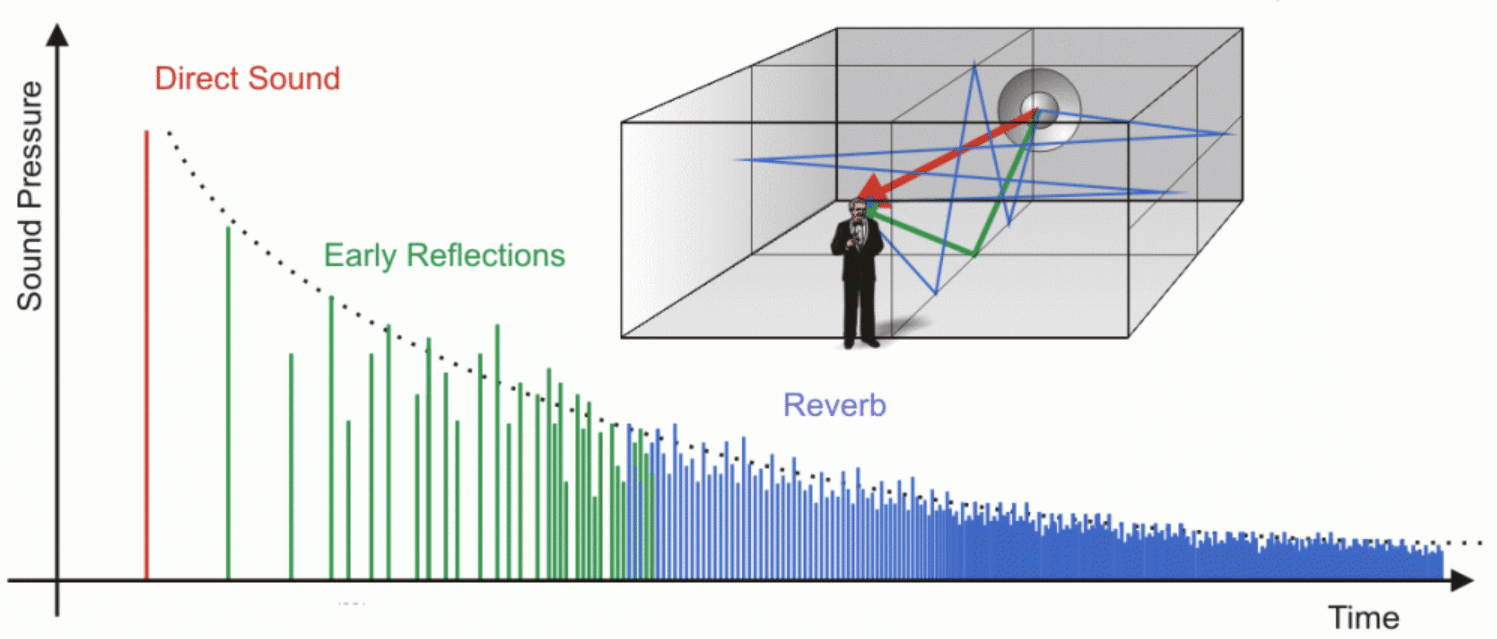
Convolution reverb uses the magic of impulse responses to replicate the acoustic characteristics of real spaces.
Each impulse response captures the unique way sound waves reflect and decay in a physical location, like a cathedral, concert hall, echoey tunnel, etc.
By applying this impulse response to any audio file (IR file), convolution reverb software can recreate the sound environment like never before.
It actually feels as though your music is being played there.
This method offers unparalleled realism, which is vital for professional production and film scoring, where accurate soundscapes can dramatically enhance the listening experience.
Convolution reverb takes your music to the next level as it relies on the quality and variety of their impulse responses.
It gives you the power to place your sounds in carefully captured real-world spaces.
-
Algorithmic Reverb
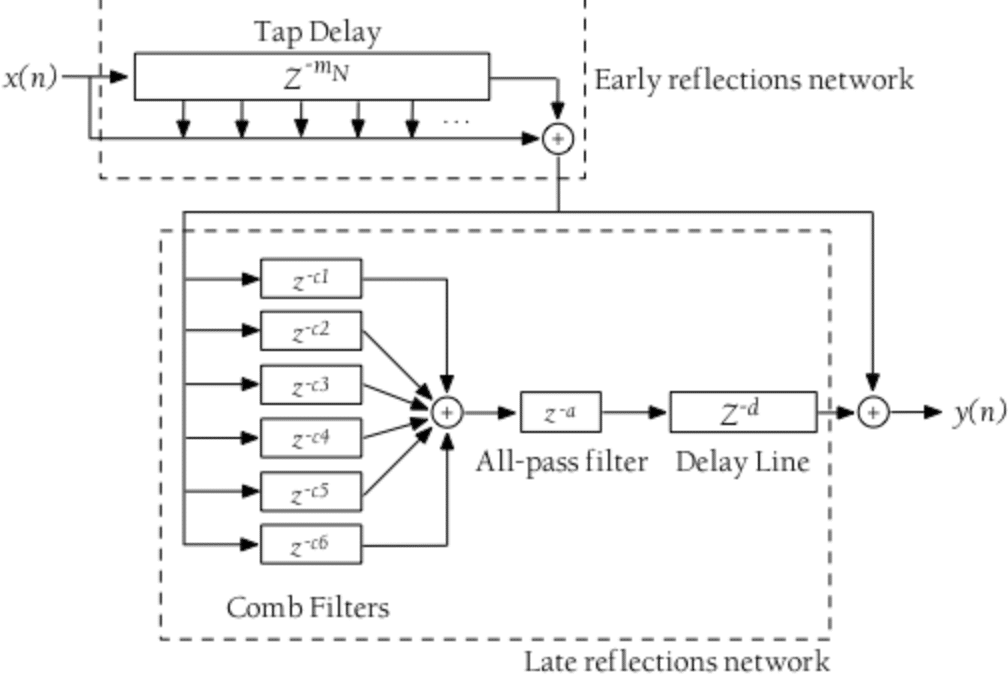
Algorithmic reverb, unlike convolution reverb, constructs the reverb effect through a series of algorithms that simulate the echo and decay of a space artificially.
This type of reverb offers a high degree of control over every aspect of the reverb effect, including:
- Modulation
- Decay time
- Reverb tail
- Early reflections
With algorithmic reverb, you can sculpt environments that defy physical reality 一 creating unique, expansive, yet realistic spaces that enhance musical creativity.
These reverbs are super useful for music producers who need to adjust and fine-tune their reverb settings in real-time.
It can adapt to both subtle and radical changes in the mix.
Algorithmic reverbs are not constrained by physical boundaries, so they give you endless creative possibilities in sound design.
-
Pro Tip: Summing it Up
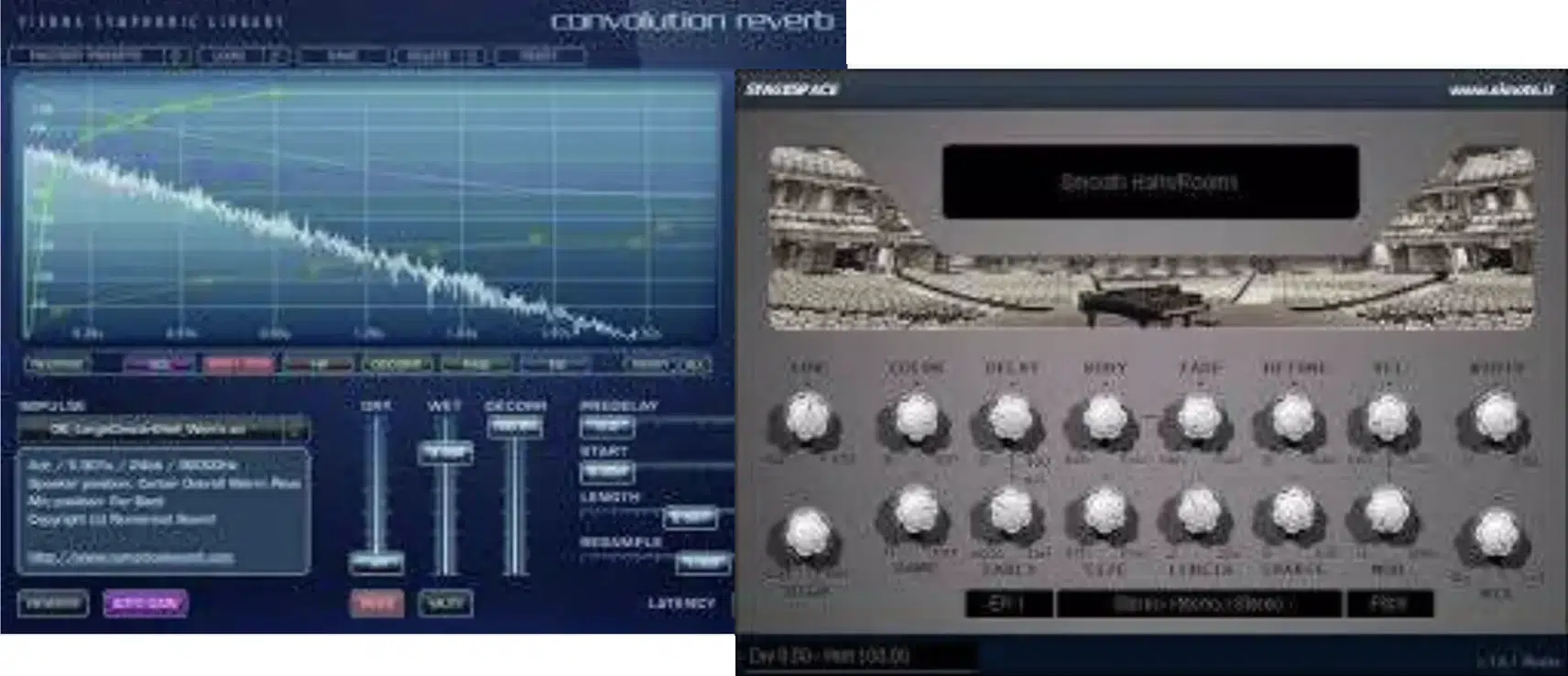
Convolution reverb excels in delivering ultra-realistic recreations of actual spaces by using recorded impulse responses.
It’s perfect for projects that demand true-to-life soundscapes.
Algorithmic reverb offers extensive creative control so you can design custom environments and tweak reverb characteristics dynamically.
It’s perfect for innovative sound design that goes beyond physical limitations.
Now that you’ve got down the basics of convolution reverb and algorithmic reverb, let’s get to the fun part: the best convolution reverb plug ins and algorithmic plug ins around.
The 7 Best Convolution Reverb Plugins
When you need to bring the authentic acoustics of real-world spaces into your productions, convolution reverbs are essential. Let’s dive into seven of the best convolution reverb plugins that leverage the precise detail of impulse response variations to enhance your mixes.
#1. Altiverb
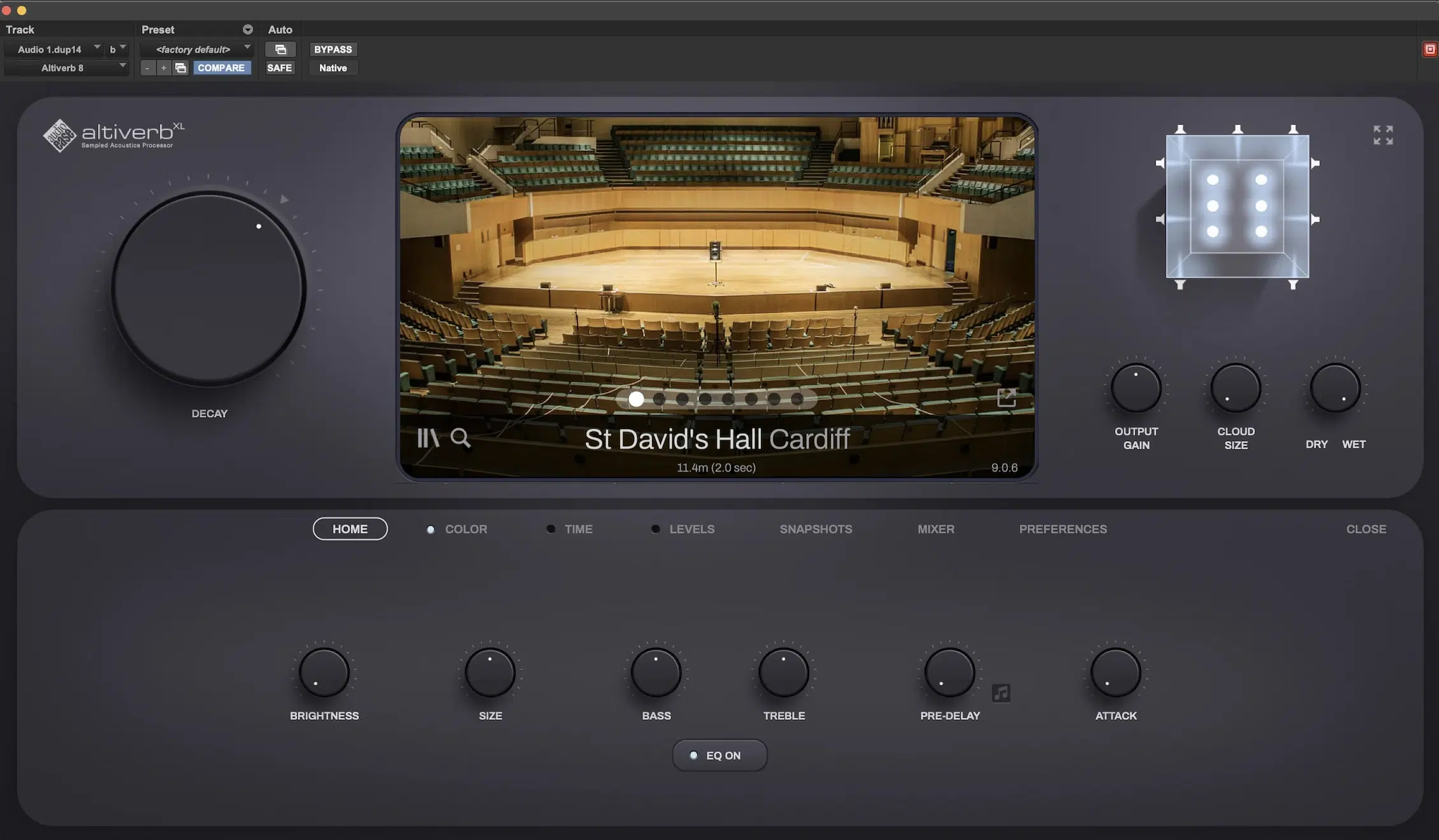
Altiverb is celebrated for its huge collection of recorded impulse responses from iconic spaces around the world.
From historical theaters to unique outdoor locations, Altiverb places these environments/live convolution reverb emulations right at your fingertips.
You can adjust the reverb tail and damping settings to blend the reverberation perfectly with the source material, which makes it super adaptable for any genre.
It also has an intuitive interface that makes searching through its extensive library a breeze, so you can achieve the desired ambiance when mixing music, designing sound for film, etc.
The power of Altiverb extends to its customization capabilities, where you can tweak convolution parameters to control:
- The size of the simulated space
- Its reflection patterns
This control is invaluable when you create specific auditory experiences or need to match the reverb characteristics of a previously recorded impulse response.
Plus, with features like total recall and presets for different types of audio samples, Altiverb stands as a top-tier choice for professionals looking to invest in a high-quality convolution reverb plugin.
Definitely the number one convolution reverb plugin on my list, and soon to be yours too (just a hunch).
#2. Waves IR1
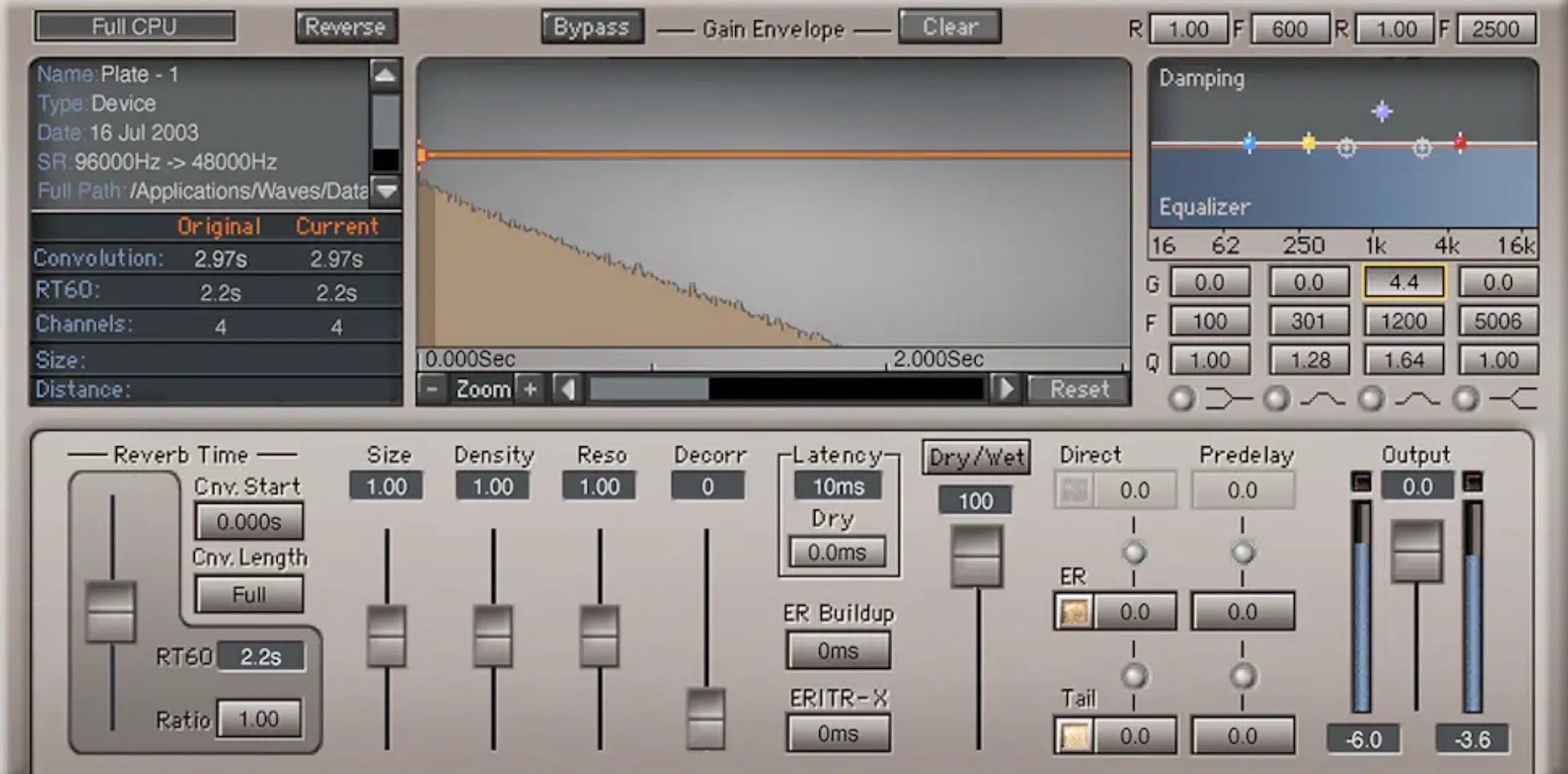
Waves IR1 is renowned for its precision and flexibility in reverb modeling.
It not only comes with a pretty impressive set of preloaded impulse response variations, but allows you to import your own as well.
This makes it an awesome tool for audio engineers who have specific impulse response requirements or who’ve captured their own impulse responses (production/movies).
The control over parameters such as decay time, early reflections, and room size provides granular customization, helping you fine-tune even the littlest details.
Waves IR1 also includes advanced features like reverb tail control and extensive filtering options 一 allowing you to mold the reverb to fit perfectly within your mix.
Whether adjusting the low-end rumble or smoothing out high frequencies, IR1 gives you the tools to ensure the reverb complements rather than overwhelms the original sound.
So, for both subtle ambiance and dramatic reverb effects, this convolution reverb plugin is top-notch.
#3. Logic Pro Space Designer
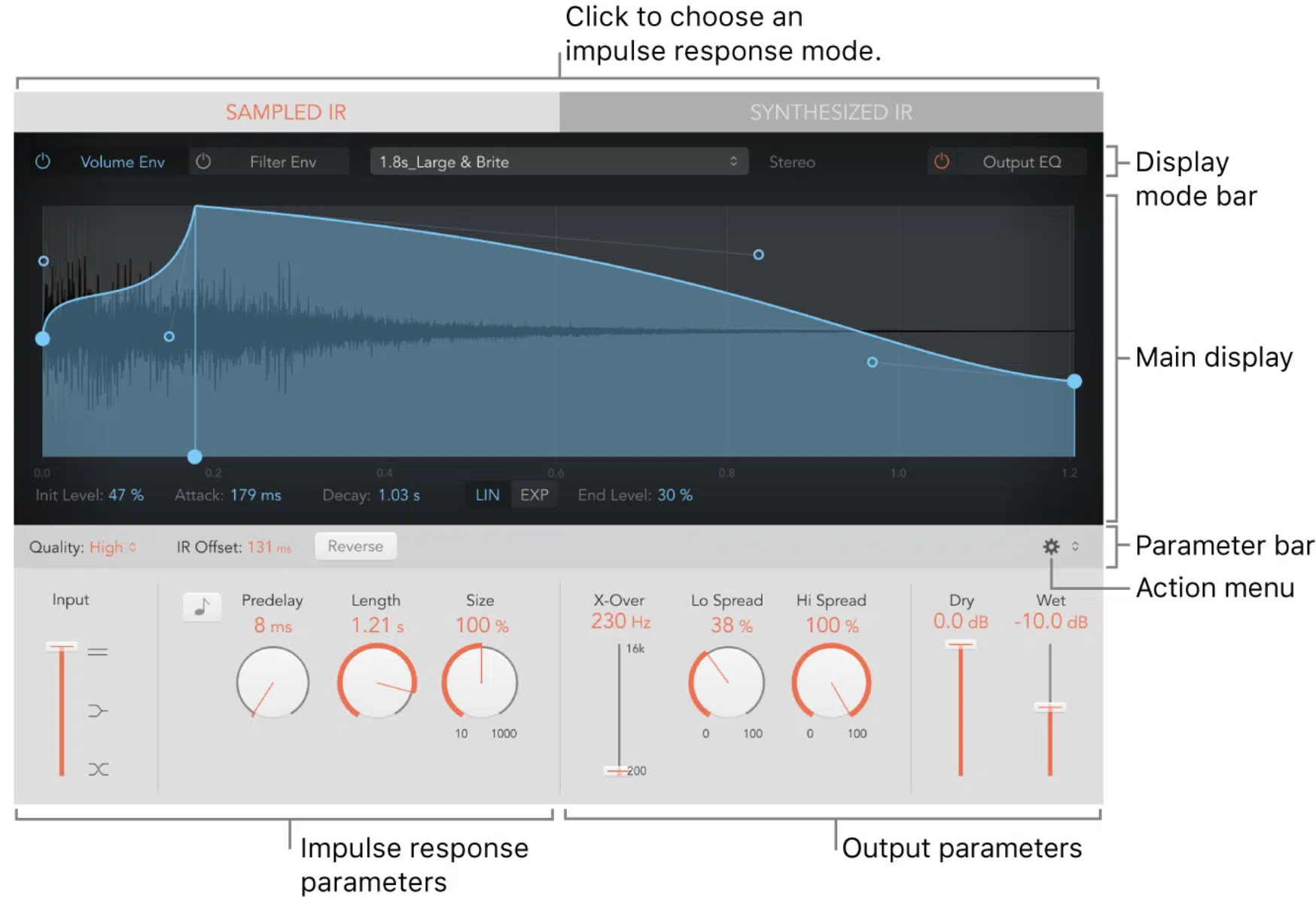
Space Designer is not just a reverb plugin… it’s an integrated part of the Logic Pro X environment that provides a seamless workflow for Logic users.
Logic Pro Space Designer is known for its real-time manipulation capabilities and various customizable settings.
With a visually interactive impulse response display, you’ll get insightful feedback on how modifications to the decay, size, and density of the reverb affect the sound.
Space Designer goes beyond basic reverb effects by offering an extensive library of impulse responses that include everything from small rooms to vast halls.
You can create some seriously mind-blowing sounds with them.
Each setting within Logic Pro Space Designer is adjustable, with parameters for pre-delay, reverb time, and an EQ section to sculpt the reverb’s tone.
This integration let’s you get super creative with your sound design techniques.
So, you can use convolution reverb not just for naturalistic echo but also as a creative tool to shape unique soundscapes, which is awesome.
#4. LiquidSonics Reverberate 3
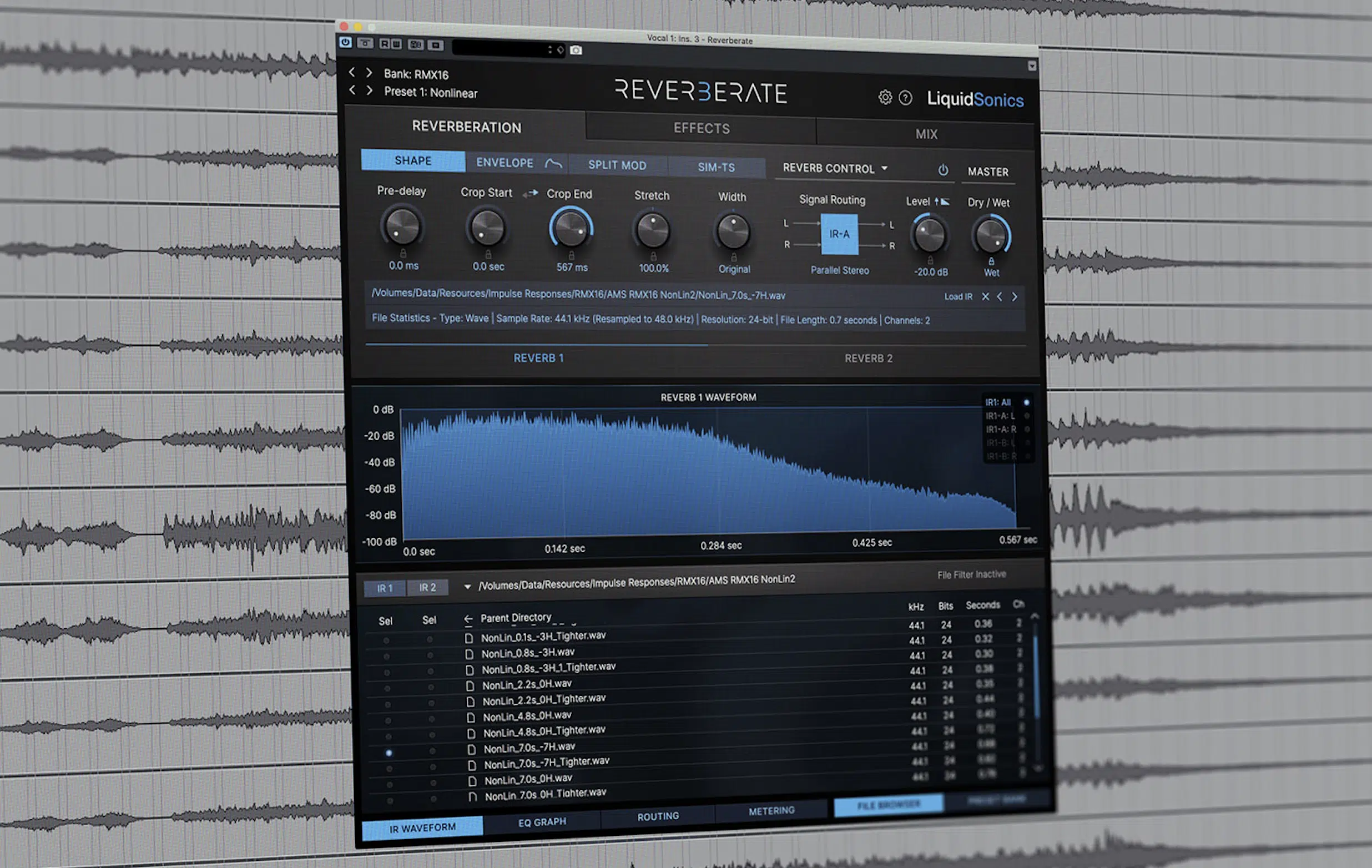
LiquidSonics Reverberate 3 stands out with its hybrid convolution engine that combines:
- The realism of traditional convolution reverb
- The flexibility of algorithmic reverbs
This dual approach allows you to layer and blend different impulse response options to create complex, evolving textures.
Textures that aren’t possible with standard convolution reverbs alone.
Reverberate 3 offers an expansive set of controls (including modulation capabilities), which add movement and depth to the reverb tail.
It will enhance the overall spatial effect.
The plugin also features an innovative Fusion-IR technology, which captures the evolving character of reverb modulation found in real spaces.
This makes Reverberate 3 perfect for simulating dynamic environments where the reverb changes with time, such as concert venues or large public spaces.
With its comprehensive set of parameters and intuitive user interface, Reverberate 3 is a powerful tool for those looking to explore the creative possibilities of convolution reverb in their sound production and sound design projects.
#5. MeldaProduction MConvolutionMB
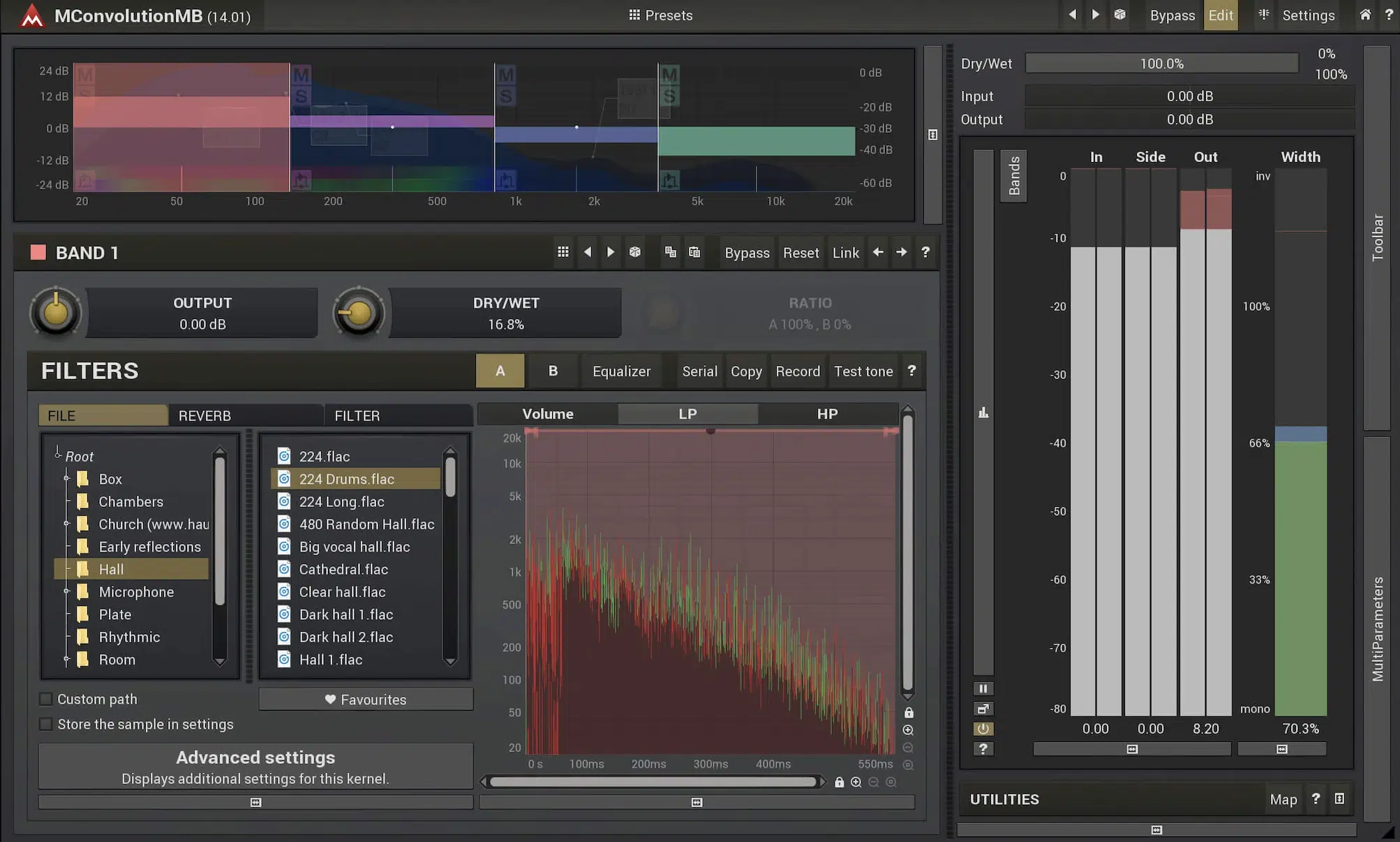
MeldaProduction MConvolutionMB takes convolution reverb to the next level by incorporating multiband processing.
This unique feature allows users to apply different reverb settings to distinct frequency bands, which gives you more control over the reverb’s impact on the mix.
For example, you might want a lush, long reverb tail on the higher frequencies while keeping the bass frequencies tight and controlled to avoid muddiness.
MConvolutionMB’s interface is both flexible and intuitive, offering an easy way to load up an impulse response and tweak it with a range of parameters including:
- Stereo width
- Delay lines
- Feedback
Beyond its multiband capabilities, MConvolutionMB stands out with its ability to modulate between different impulse responses 一 creating a dynamic reverb effect that can evolve over time.
This is ideal for sound designers and electronic music producers who wish to incorporate movement and texture into their tracks.
NOTE: It also includes a comprehensive suite of audio effects, like EQ and distortion, which can be applied directly to the input signal.
This makes it even more versatile for anyone looking to push the boundaries of traditional convolution reverb.
#6. Avid Space
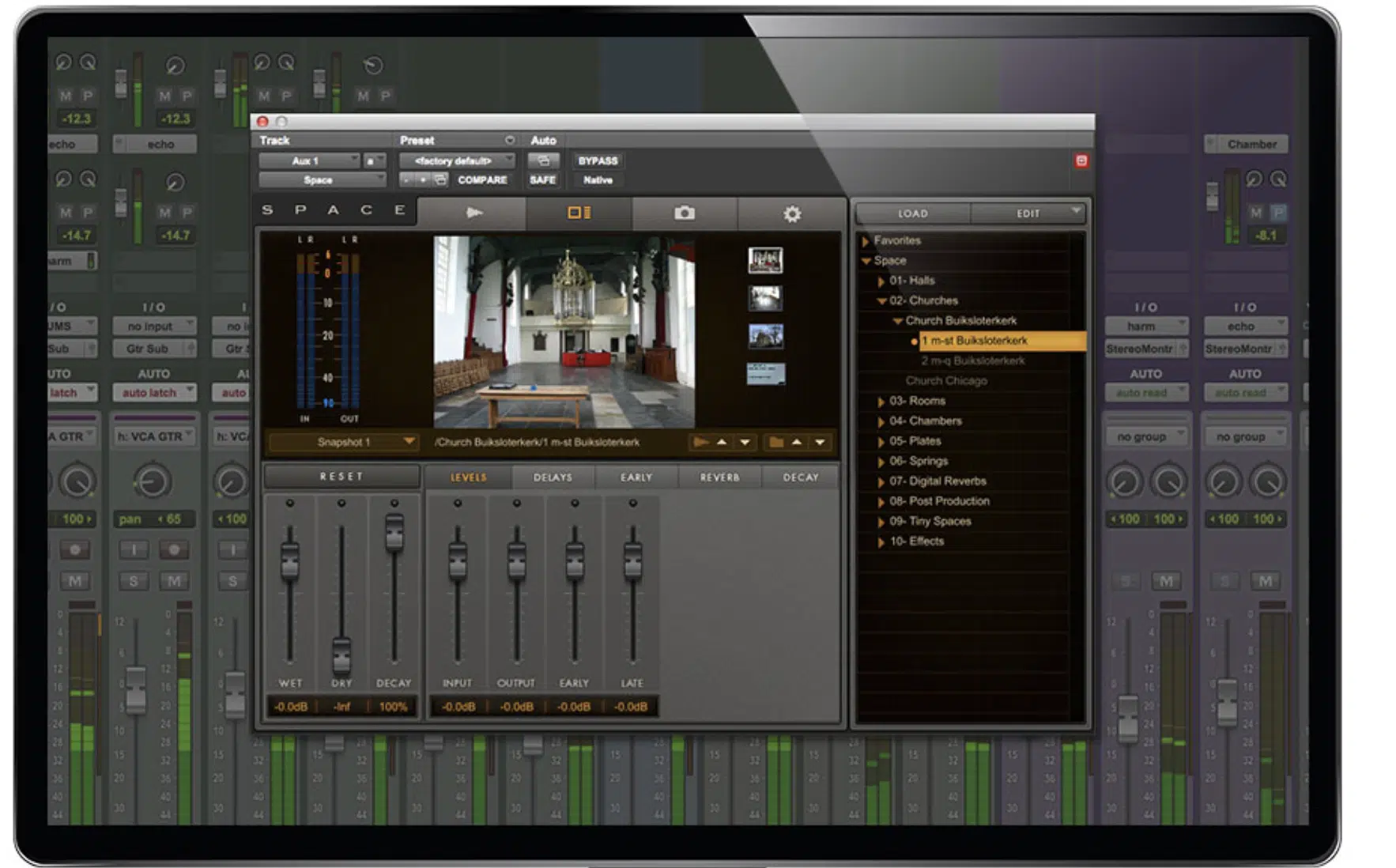
Avid Space is widely recognized in the audio post-production community for its depth and realism, often used to bring cinematic environments to life.
This convolution reverb plug in provides a vast library of high-quality impulse responses, from tight rooms to sprawling landscapes, designed to fit seamlessly into any mix.
Space excels in its attention to detail, offering adjustable parameters such as:
- Diffusion
- Pre-delay
- Decay optimization
So, adding reverb to the specific needs of your song is easy as ever.
What sets Space apart is its deep integration with Avid’s Pro Tools, which makes it a go-to choice for professionals in production, film, and television.
Its efficient processing ensures that even the most subtle nuances of a space are captured, helping sound engineers create immersive soundscapes that truly transport the audience to another world.
Bottom line, Space delivers a level of precision and realism that is super beneficial for professional sound design.
#7. Vienna MIR Pro
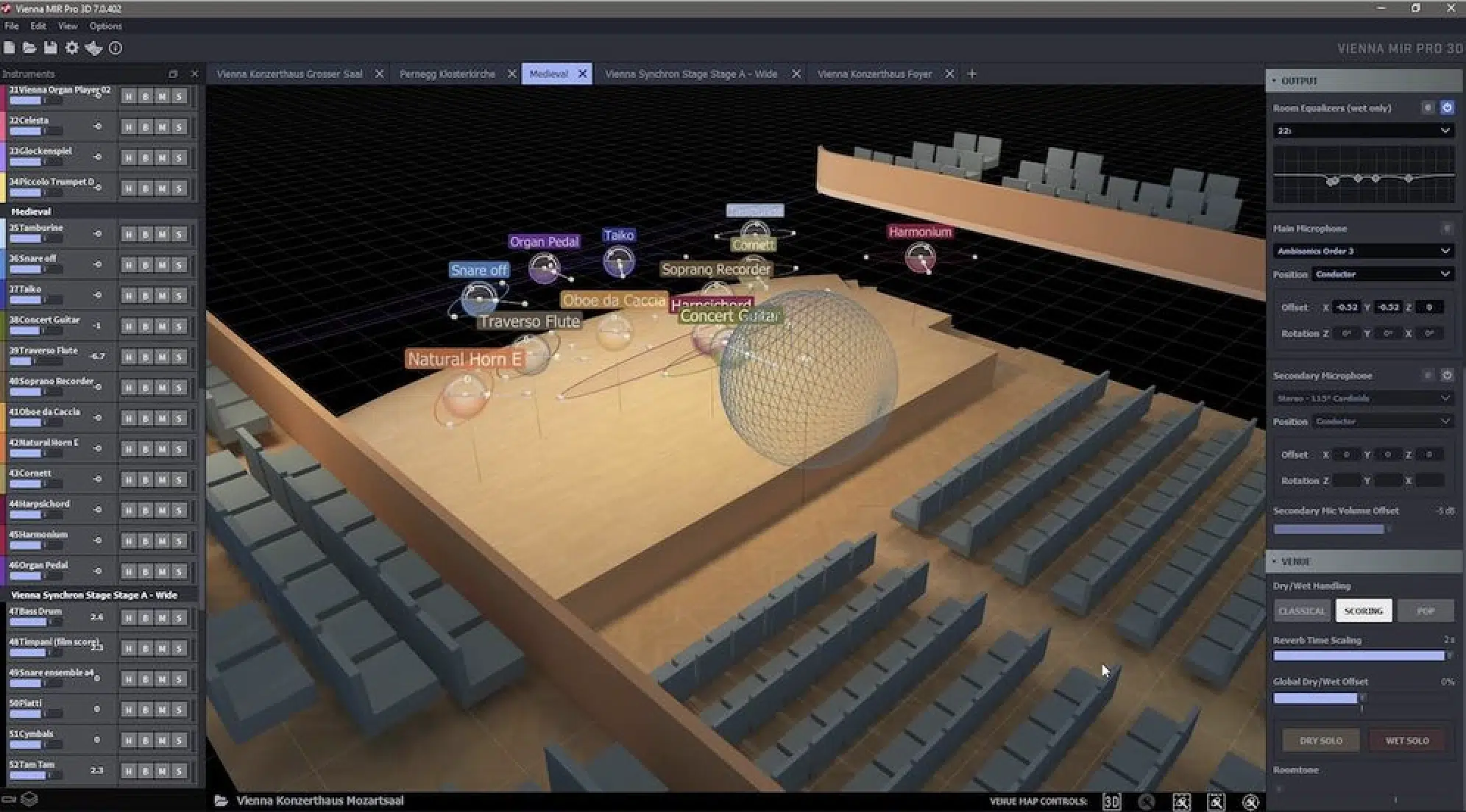
Vienna MIR Pro is more than just a convolution reverb 一 it’s an integrated multi-impulse response mixing and reverberation environment.
It’s especially perfect for orchestral arrangements and large-scale productions.
This epic software takes into account the positioning of instruments in a virtual space; not just treating reverb as an effect, but as an integral part of the overall mix.
It allows users to place audio sources in a 3D environment, adjusting each element’s:
- Direction
- Strength
- Distance relative to the chosen impulse response
The strength of Vienna MIR Pro lies in its holistic approach to acoustic virtualization.
It provides a platform where the acoustic characteristics of all your instruments can be finely tuned to perfection.
Basically, that’s a fancy way of saying you can ensure the reverb blends naturally with the timbre and dynamics of each instrument.
NOTE: This is key for classical music producers and those involved in any intricare ensemble recording projects.
Additionally, Vienna MIR Pro includes features like RoomEQ and Air absorption, which further refine the sonic characteristics to match the performance space’s physical attributes.
For music producers and sound designers seeking to create a more realistic sound with dynamic acoustic simulations, Vienna MIR Pro offers unparalleled options.
The 7 Best Algorithmic Reverb Plugins
When precision and flexibility are key in crafting your soundscapes, algorithmic reverb plugins are indispensable. The following 7 algorithmic plugins can help you create everything from subtle room ambiences to expansive, otherworldly spaces. They offer unlimited creative control over your reverb effects, so let’s dive into these classic digital reverbs.
#1. Valhalla Room, VintageVerb & Plate
Valhalla DSP offers an epic trio of revered algorithmic reverbs:
Each unique plugin is designed to cater to distinct sonic needs, like the following.
#1. Room
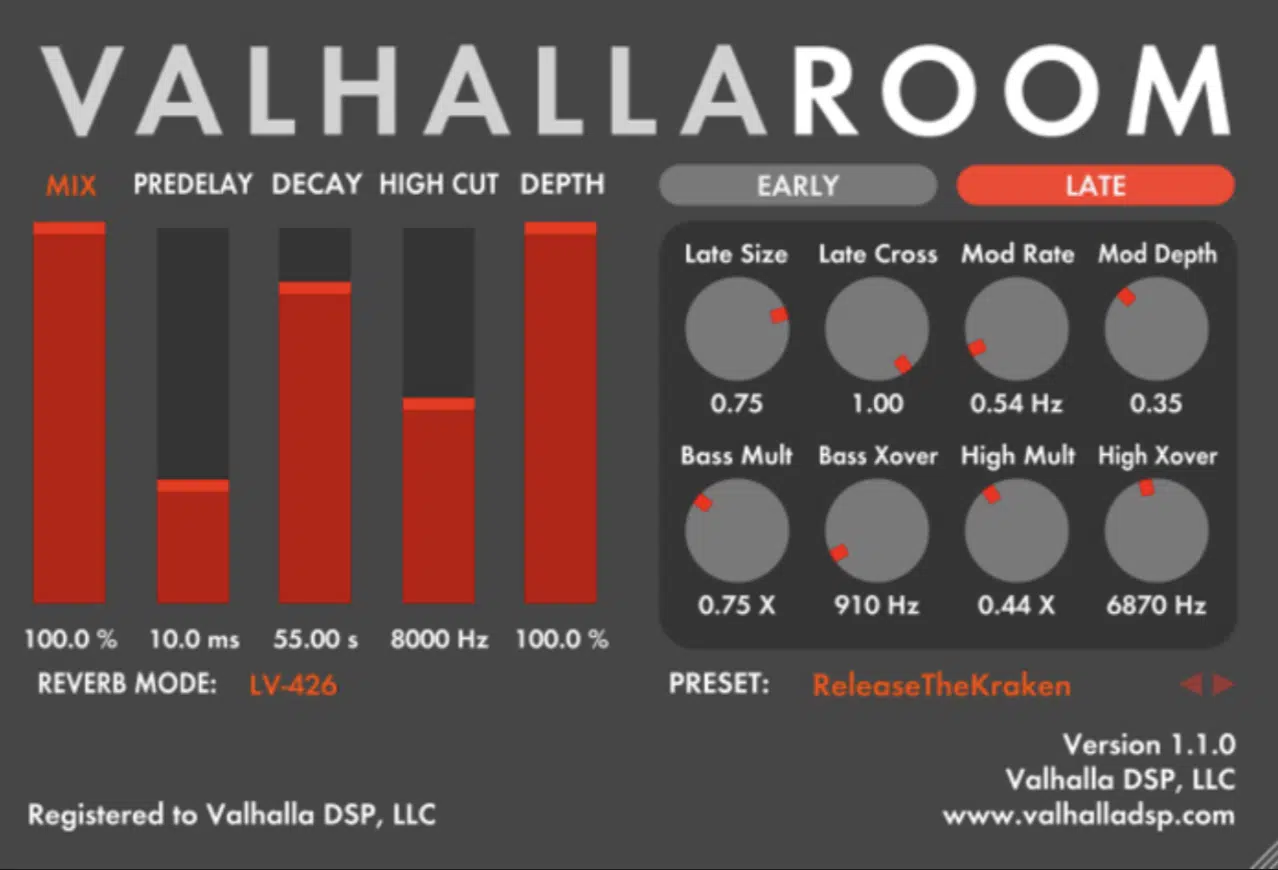
Room is perfect for realistic room simulations, providing clear, spatial reverb without muddying the original sound.
#2. VintageVerb
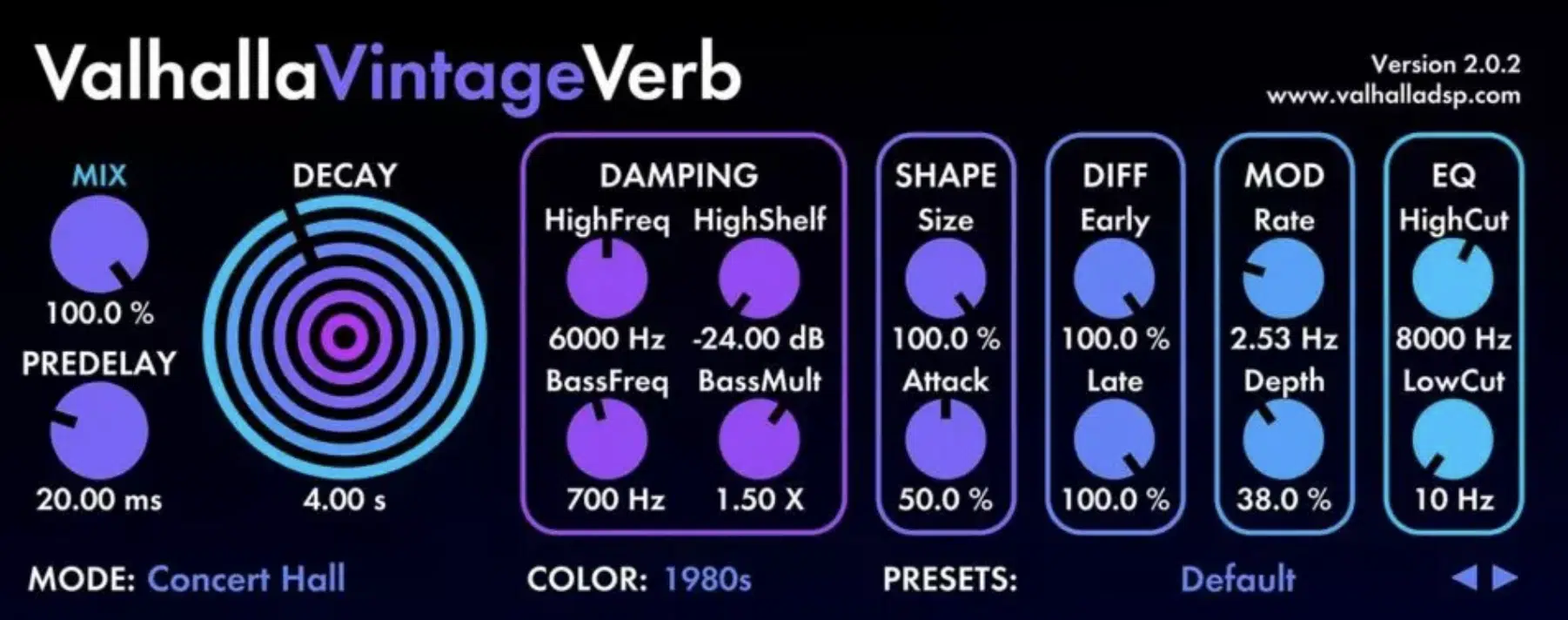
VintageVerb offers a nostalgic take on reverb, emulating the classic units of the 1970s and 1980s with its colorful and dense tails that add a warm character.
#3. Plate
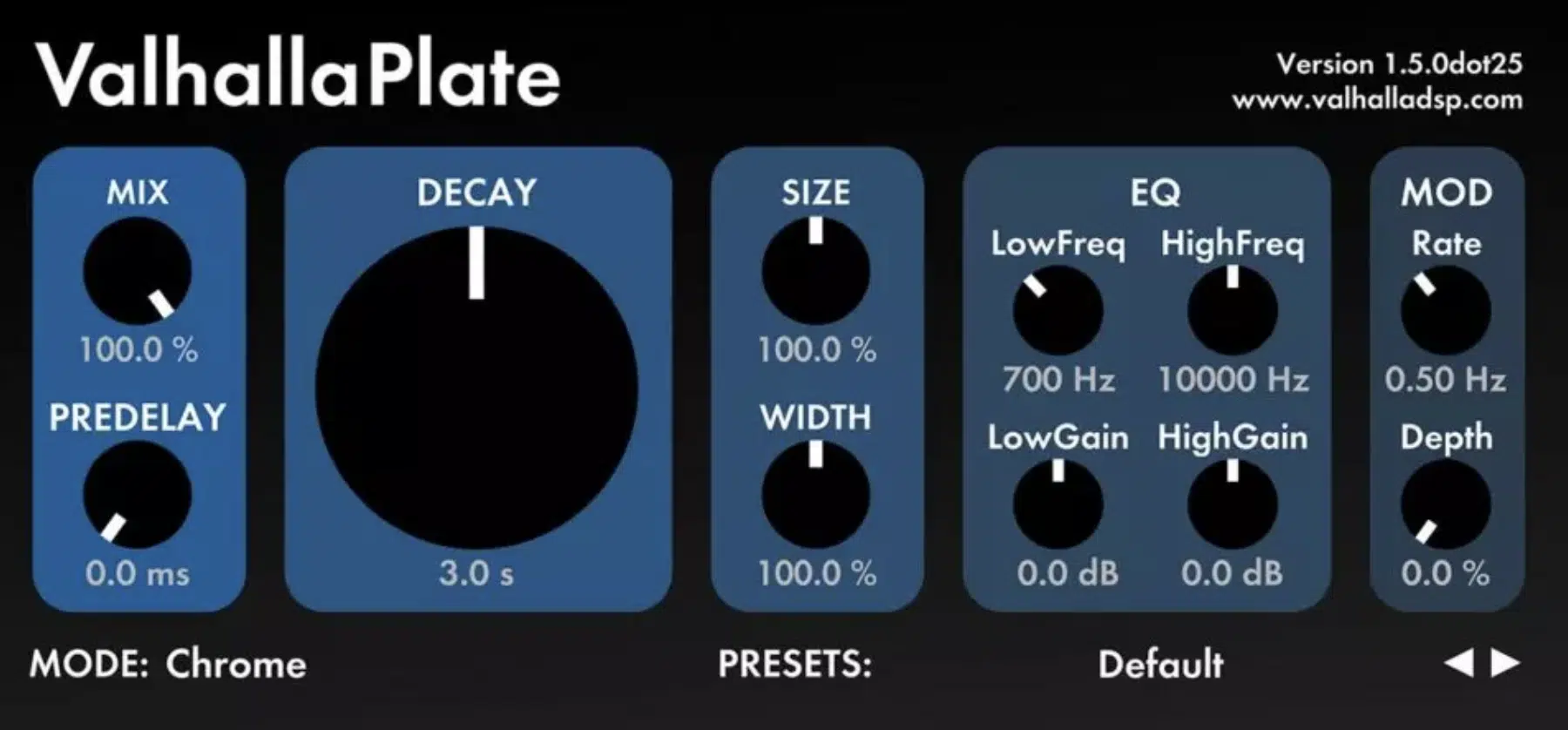
Plate, on the other hand, recreates the bright and smooth textures of a metal plate reverb, ideal for vocals and percussion.
Each plugin features a minimalist interface with a wealth of parameters 一 allowing for detailed sound shaping while maintaining ease of use.
This makes the Valhalla suite versatile for both new producers and professional sound engineers looking for quality and efficiency in their reverbs.
#2. FabFilter Pro-R
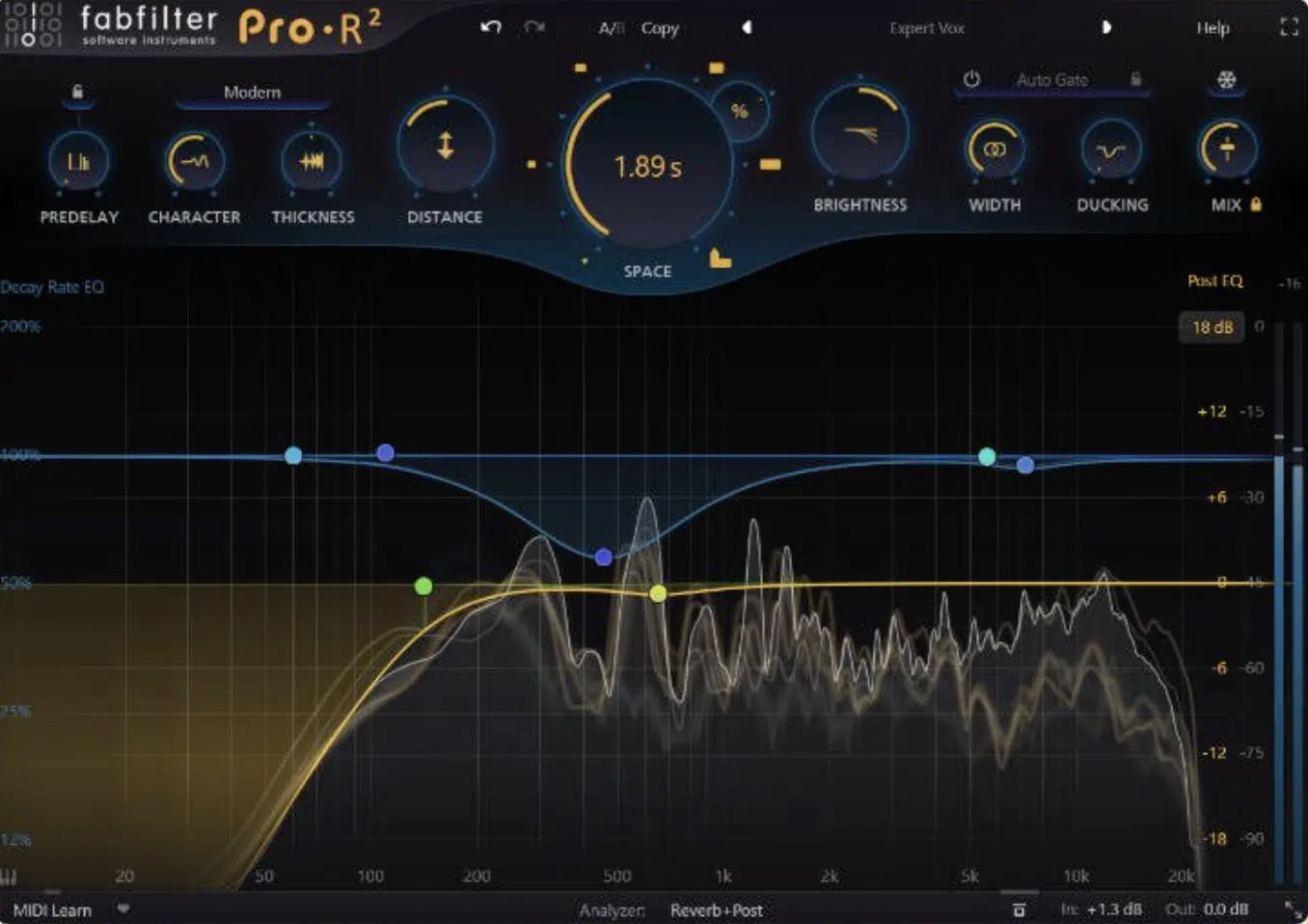
FabFilter Pro-R is designed with the philosophy that reverb should be treated as a musical instrument…
It stands out with its intuitive design that maps out reverb characteristics in a super musical way, featuring parameters like:
- Brightness
- Character
- Distance
It will help you shape the reverb to fit the mix naturally.
The plugin also includes a unique decay rate EQ that enables fine-tuning/adding reverb decay across different frequencies.
It makes sure that it complements the source material without overpowering it.
Whether you’re adding a subtle touch to a delicate acoustic set or enveloping a whole orchestra in a lush space, Pro-R provides both precision and creative control.
This makes it a top choice convolution reverb plugin for high-end music production.
#3. Lexicon PCM Native Reverb Bundle
![]()
Lexicon has long been synonymous with the highest standard in reverb, and their PCM Native Reverb Bundle continues this legacy.
It offers a suite of algorithmic reverbs that emulate Lexicon’s famous hardware processors.
This bundle includes various options with detailed control over every aspect of the reverb 一 from pre-delay and reverb time to multilayered reverb tails.
Each algorithm is created to produce rich, enveloping, and dimensionally complex reverb that can be subtle or made to steal the show (depending on the goal).
Its high-fidelity sounds make it an industry standard, especially favored in professional recording studios for its reliability and the signature ‘Lexicon sound’ that has shaped countless hits.
#4. Eventide Blackhole
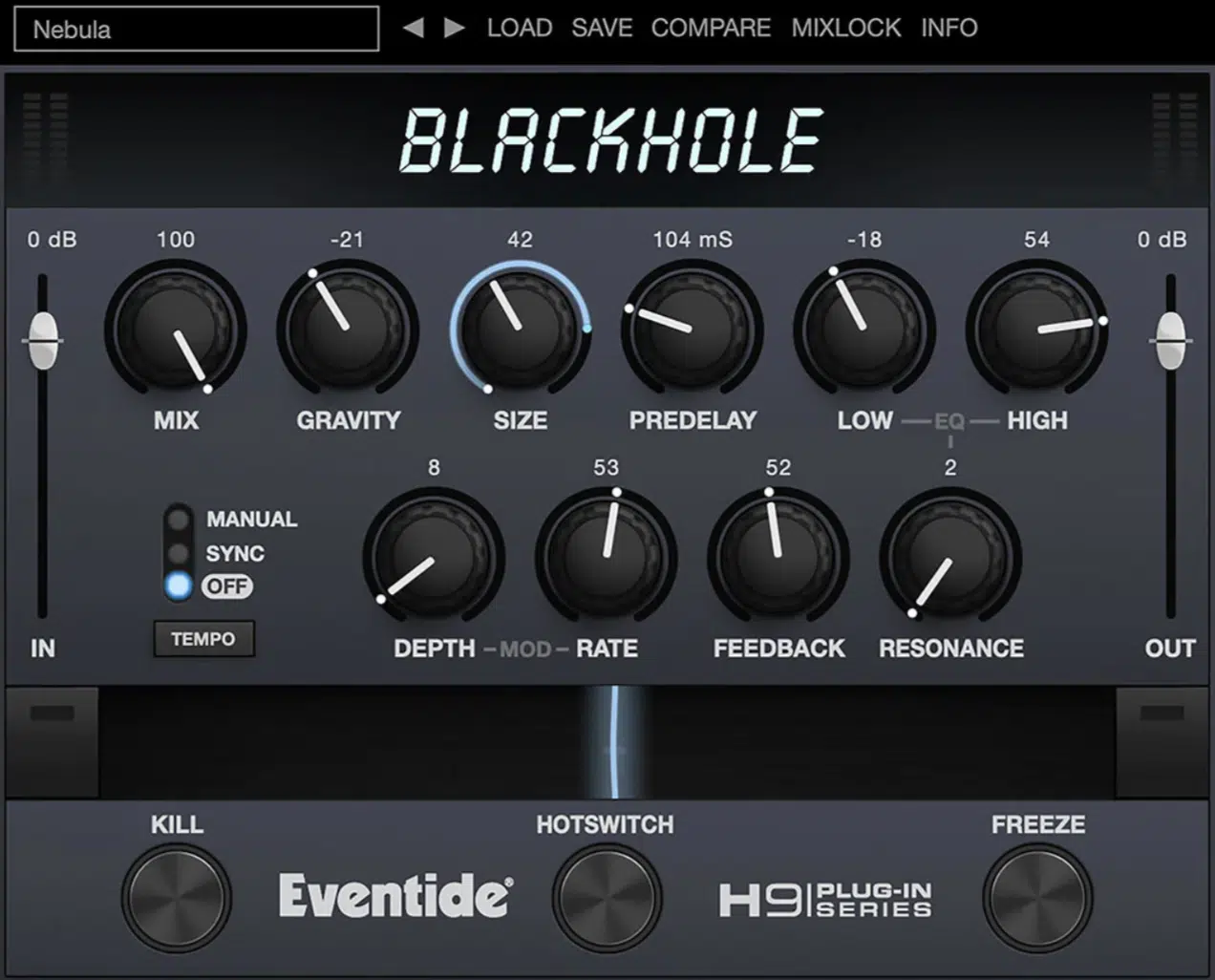
Originally designed for creating massive reverbs in sound design and post-production, Eventide Blackhole has become a favorite of music producers everywhere.
This is thanks to its ability to generate vast, ethereal spaces that go beyond the constraints of physical reality.
Blackhole is ideal for creating dramatic soundscapes and otherworldly textures.
It features extreme control over every parameter, including:
- Gravity 一 Dictates the size of the reverb tail.
- Motion 一 Adds modulation to create a dynamically evolving atmosphere.
This algorithmic plugin is not just a reverb but an instrument in its own right, capable of transforming simple sounds into complex masterpieces.
So, if you’re looking to add some serious depth to any track, give this one a spin for sure.
#5. Softube TSAR-1
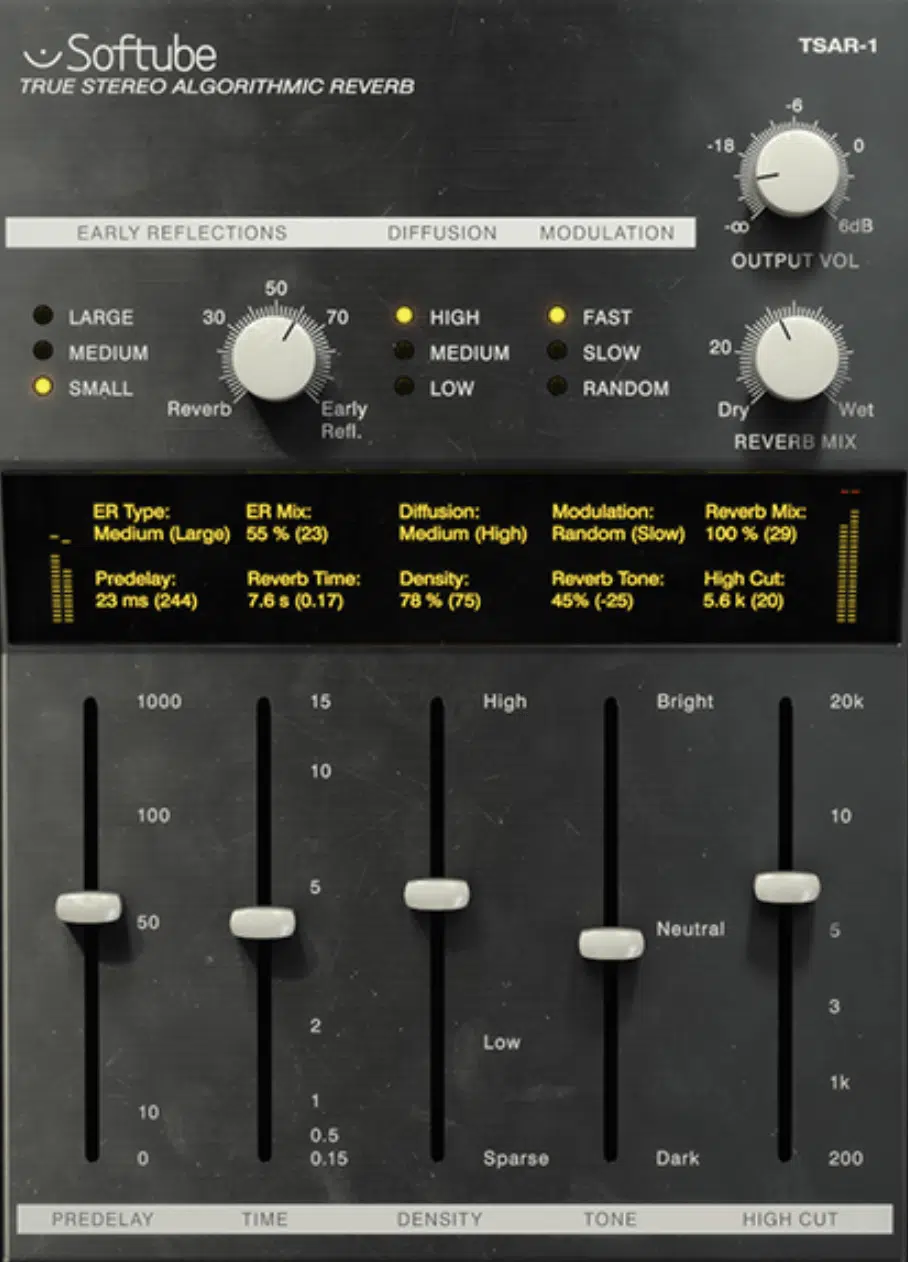
Softube TSAR-1 (True Stereo Algorithmic Reverb) shines above the rest for its straightforward, user-friendly interface and sonic versatility.
TSAR-1 is designed to handle everything from natural small room reverbs to dense and dramatic halls, like all the best reverbs will.
It offers simple controls but powerful sound shaping capabilities, with parameters that allow you to dial in the exact space and character needed/desired.
The sound quality of this algorithmic reverb plug in is pristine and detailed 一 making it suitable for both audio mixing tasks and more creative sound design possibilities.
TSAR-1 is praised for its efficiency and ease of use and provides professional-grade reverb without extensive tweaking, which is always a huge plus.
#6. Relab Development LX480
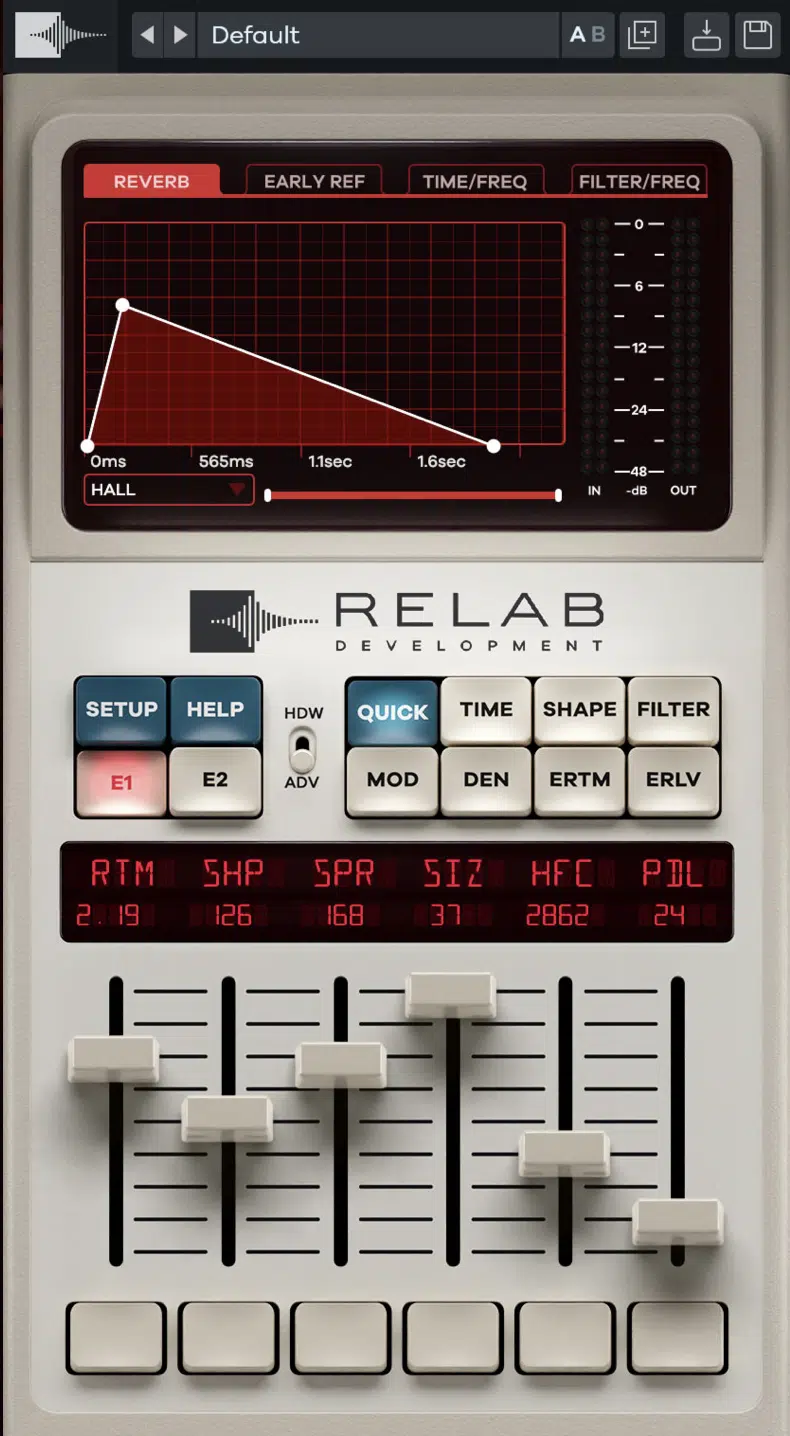
Relab Development LX480 is a seriously impression recreation of the legendary Lexicon 480L digital reverb unit, known for its distinctive, ethereal reverb.
It’s been a staple in studios around the world for as long as I can remember.
LX480 offers a comprehensive set of classic presets and new capabilities that secure its place in many modern production environments.
It provides deep control over every aspect of the reverb, including:
- Diffusion
- Modulation
- Decay optimization
Meaning, all of your sounds can be tweaked to perfection.
It captures the essence of beloved vintage hardware reverbs with the flexibility of digital reverbs to help you create true masterpieces.
So, if you’re looking for that classic Lexicon sound with a modern twist, this one is perfect for you.
#7. IK Multimedia Sunset Sound Studio Reverb
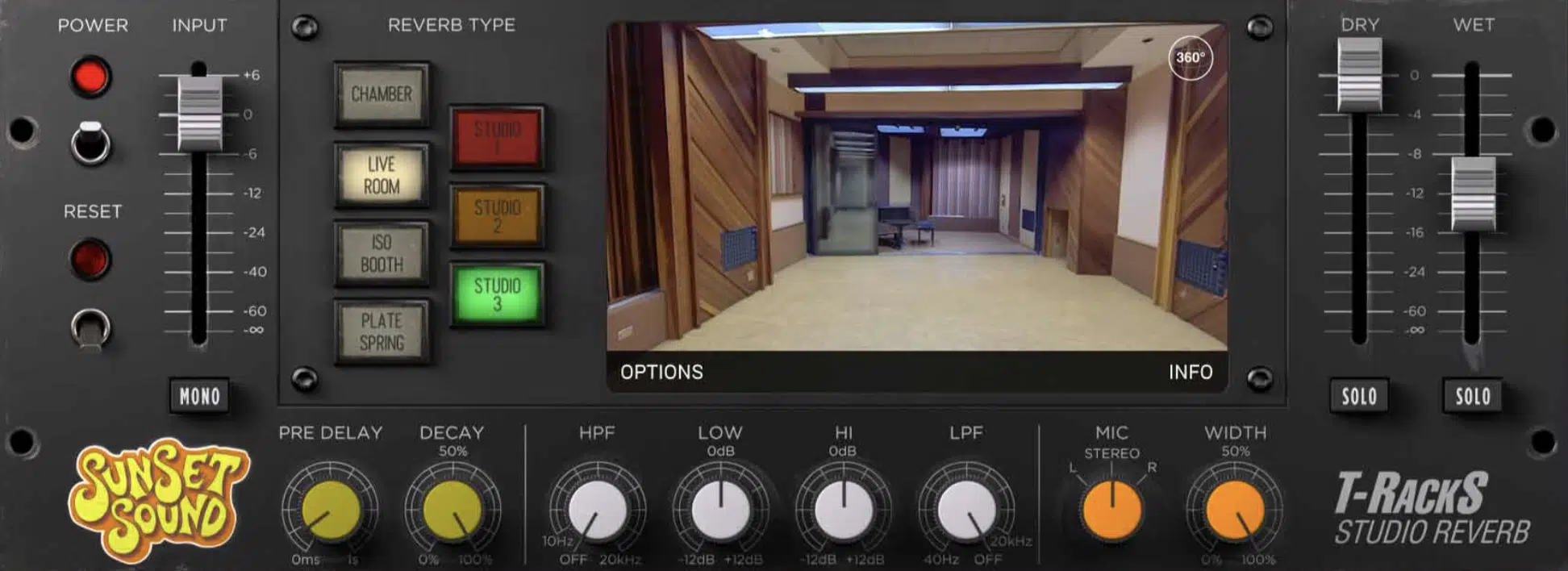
IK Multimedia Sunset Sound Studio Reverb brings the distinct acoustic characteristics of the famous Sunset Sound studio right into your DAW.
It masterfully emulates the studio’s echo chambers and reverb plates 一 offering a rare (invaluable) glimpse into the sounds that have defined countless records you know and love.
With precise modeling of the studio’s spaces and its hardware, you can capture the exact same ambience that has contributed to legendary recordings.
And, when it comes to extensive customization, it doesn’t slack there either, with control over pre-delay, decay, and the balance between direct and reflected sound.
It will help you achieve the perfect blend for your unique tracks/sounds.
Sunset Sound Studio Reverb not only brings historical soundscapes to modern productions but also provides you with the keys to adjust the sonic characteristics.
So, rest assured that the reverb will fit like a glove in any mix.
Convolution Reverb/Algorithmic Reverb: Final Thoughts
Convolution reverb and algorithmic reverb are two very powerful tools in the music production world that offer unparalleled depth and spatial texture to your mixes.
Plus, they help you capture the essence of real-world spaces or create entirely new and innovative environments.
The right plugins can make that process so much easier, and any of the ones we covered today can certainly get you there.
To further enhance your production skills, you do NOT want to miss out on these highly-renowned, completely Free Project Files.
It includes 3 invaluable project files that give you inside access to exactly how professional tracks are broken down 一 mirroring the most popular hit songs in modern music genres.
So, dive into these project files and try swapping the default reverbs with some of the convolution or algorithmic reverb plugins discussed today for some pretty mind-blowing transformations.
You’ll instantly hear the magic they are capable of producing.
And yes, everything is 100% royalty- and copyright-free, so you can use it however you want.
Remember, the world of reverb is vast and full of possibilities, so never stop experimenting with different reverb types and techniques to create show-stopping music that people never forget.
Whether you’re a rookie producer or a seasoned vet, mastering these tools can elevate your sound to a professional level.
Until next time…







Leave a Reply
You must belogged in to post a comment.